Gardening Without Plastic, Part 1: Raised Beds and Plastic-Free Soil
Last Fall, Rodale.com’s Dana Blinder contacted me about plastic-free gardening. What she didn’t know was that I had already failed miserably in the gardening department several times and wasn’t sure gardening was my thing. That’s when we came up with a brilliant idea. Rodale would teach me how to grow an organic garden, and I would figure out how to do it with the minimum plastic possible.
My guru for this project is Rodale’s Eric Hurlock, Associate Online Editor for “Organic Gardening.” First, I sent him photos of my postage stamp front yard, the only space available for a garden. (My neighborhood in Oakland, CA, is in Zone 8B, according to the USDA Hardiness Zone Finder.)

I explained that the yard is basically hard clay that is overrun every Spring by tough little yellow flowers that refuse to be pulled up. Each year the landlord sends some guys over to chop the weeds down, but they’re never uprooted. I’m betting the roots are taller than me at this point.
Eric suggested that instead of trying to make my hard, weedy soil hospitable to vegetables, I should build a raised bed filled with rich, organic soil on top of it. Oh dear. I’m building now? I could see this project was going to be more complicated than buying a bunch of plants and sticking them in the ground. Still, I was committed. And I wanted to not only make this garden plastic-free but as low impact as possible. So I asked about using salvaged lumber for the frame of the raised bed instead of brand new wood.
Eric said no. For an organic garden, secondhand wood would not work because it might have been treated with toxic chemicals in its previous life, and we’d have no way of knowing. So instead I looked for new lumber certified by the Forest Stewardship Council (FSC-certified) to be from sustainably-managed forests. I rented a pickup truck from Zip Car (the car share service I belong to so I don’t have to own a car) and scooted over to Ashby Lumber in Berkeley, which I discovered carries plenty of FSC-certified wood.
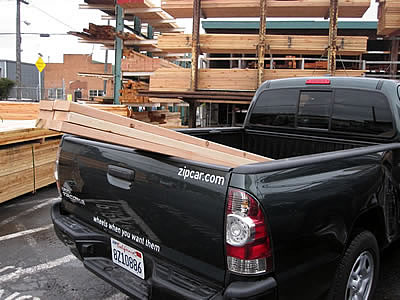
I purchased nails from the bulk bin at the hardware store, tossing the amount I needed into a brown paper bag, which I will be sure to reuse.
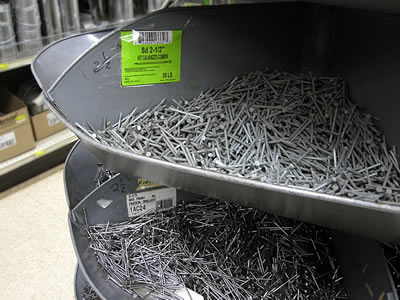
Michael sawed the boards to the right length for me (my arm’s been acting up), and then I set to work building my 6′ x 4′ x 12″ box.
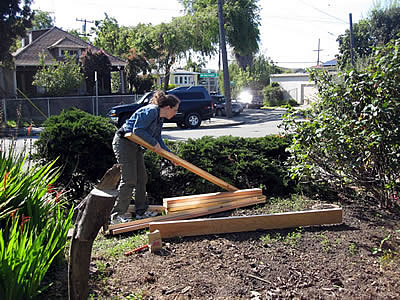
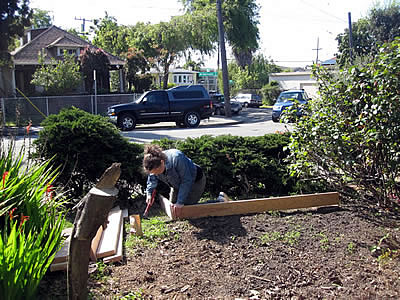
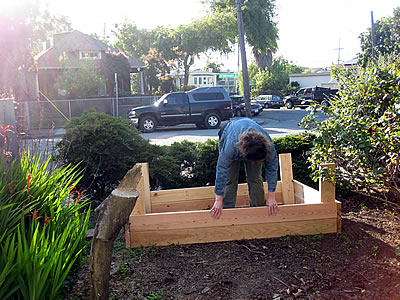
But what would I put under my box to keep the weeds from coming up through the new soil I would buy? Black plastic, popular among so many gardeners, was obviously out.
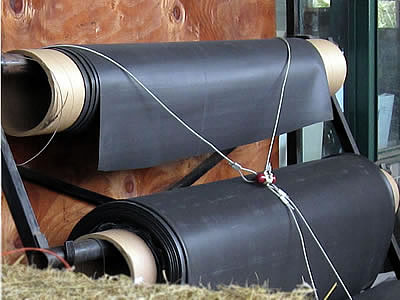
Eric suggested used cardboard instead. Perfect. We have an attic full of broken down cardboard moving boxes. I used a few of those.
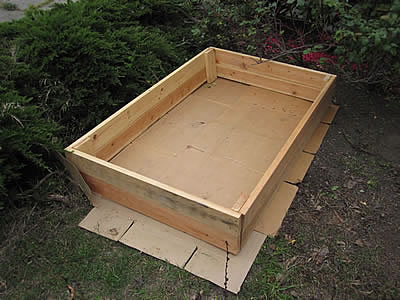
And then I had to find a way to fill the box with soil without ending up with a billion plastic bags.

Some companies, like American Soil and Stone in Richmond, CA, sell soil and amendments in bulk. They can dump it into your own truck or deliver it to your door. Bright and early one Wednesday morning, a big truck pulled up loaded with “Local Hero Veggie Mix” (Contains: Sandy Loam, WonderGrow Organic Compost, Rice Hulls, Chicken Manure, Grape Compost, Fir Bark, Cocoa Bean Hulls) for me. “I hope you can use extra,” the driver said, “because I have way more than you ordered.”

Sure! More is always better, right? Um… not if it’s Wednesday morning, and the guy dumps the dirt right in the middle of the sidewalk, and you have to shovel all of that dirt off the sidewalk before leaving for work, all the while praying that someone in a wheelchair doesn’t need the sidewalk before you’re done. But I did it. I was prepared with my shovel, as well as a wheelbarrow I had borrowed from our local tool lending library. Yep, the wheelbarrow is plastic, but according to my plastic-free rules, borrowing and sharing durable plastic goods, instead of buying new, is not just allowed, it’s encouraged.

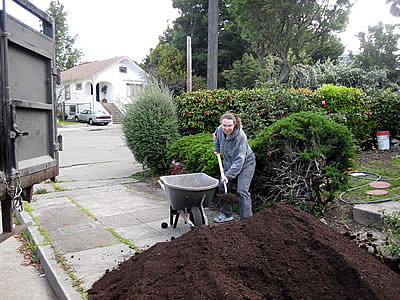
I shoveled all morning until my shoveler was sore. And as you can see, I did end up with way more dirt than would fit in my little raised bed frame.

But it turns out that that’s good. Because Eric says that I shouldn’t plant my squash or cucumbers, which tend to spread out, in the box but in mounds of their own outside the box. I’ll also use some of the dirt to grow herbs in terra cotta pots. All this talk of veggies and herbs leads me to my next plastic-free dilemmas:
1) Buying plants that don’t come in plastic pots. I can plant seeds from paper envelopes, but Eric says that I should not grow tomatoes and peppers from seeds but from seedlings. And what about those plastic markers they inevitably come with?
2) Finding a plastic-free garden hose. Does such a thing even exist? And if not, what’s the most eco-friendly hose I can buy? Or is there a better way to water? I haven’t found a plastic-free hose, but I have found ones that supposedly have fewer leaching chemicals. But some people have recommended skipping the hose altogether. One of my Facebook friends recommends ladling water from a metal bucket. And one of the Rodale readers suggests a metal watering can. What do you think?
3) Finding plastic-free gardening gloves. My hands were pretty calloused after all that shoveling, and my fingernails were a mess. A pair of gardening gloves would be nice, but I’m not interested in gloves made with vinyl or polyester, and I’m a vegetarian so I don’t want leather or suede either.
Do you have advice for me? I’d love to hear it.








Good for you! I’m impressed and inspired!
We used newspaper as a weed block on the top surface of our garden this year. (It is held down by a thin layer of mulch dropped off for free from a local tree trimming company. It seems to be working well where we made the layers thick enough. Next season we can just till it into the garden. Your space is small so a watering can might do the trick! Metal ones do last forever and you might find them at a flea market for sale. Try the one at De Anza college! It is amazing.
We have an organic terrace garden and your post made me realize the plastic pieces in it – the bottom of the box is plastic, and there are some pots that are plastic that came with the plants we bought from a nursery – we didn’t want to throw it anyway. We didn’t buy a plastic hose(garden is small), but use a plastic water can. And we bought a pair of glows too – but decided not to use it. It was uncomfortable and latex.
Your awesome! Think I’m extra touched by this post as I’ve just started growing as well. I have caved in on the gloves though…. & I still have blisters! have you found an answer to seed potting? I’ll post a pic to your facebook of a magic machine a friend lent me.
Another friend said Goats shit is the shit! But I know it’ll come in bags… so I’m off to get loose horses from a friend instead today. Another bag saved!
Go, Beth! I am so impressed. I too am a recovering garden failure. I take great interest in your evolution. Maybe I will give it another go! Keep posting your progress, I’d love to hear it.
A 10′ length of 3′ high fencing looped into a circle makes a quick, inexpensive compost bin. Keep some bags of leaves to layer with your kitchen scraps and throw on some soil once in a while and you’ll have compost in 6 months. Make sure to keep the pile moist, but not wet. Also, a cheap stainless steel stock pot with a lid makes an attractive, cleanable indoor compost bucket.
Regards the cost of a metal watering can – yes, they are definitely expensive, but my mum’s is still going after 15 years 🙂
Show me a plastic watering can that can match that record! Given that if the plastic doesn’t become brittle and crack, the nozzle will probably throw a wobbly and there’ll be no replacements to be found. (guess who’s a convert..)
I haven’t read the comments so you may have heard already, but they make gloves that are cotton canvas-type material. You can find them all over in fact I saw some the other day with no plastic packaging, but i prefer a different kind of glove so I didn’t think much about it. As far as watering is concerned. If you can be dedicated you do not need a hose, but you will need an outdoor faucet/spigot of some sort. Get a bucket or watering can (you can find plenty of metal ones post to criagslist/freecycle/etc and i bet you’ll find one)
peajayFish, Oakland does have city-wide composting, so I have been lazy about composting my own food scraps for the past couple of years. I did buy a compost tumbler made from recycled plastic back in 2007. Here’s my post about various compost tumblers:
http://myplasticfreelife.com/2007/08/compost-tumbler-solution-to-potting/
And here is my less than enthusiastic update about the one I chose:
http://myplasticfreelife.com/2008/03/update-2-urban-composting/
I’m considering starting up again with the kind of composter that sits on the ground because now I do have room for it. And yes, I too have been worried about killing worms.
Wow! You already got all the best ideas for gloves, watering, etc. You have some awesome followers.
This post is so timely for me! I too want to start a small and plastic-free garden on a postage stamp yard with clay ground. I’m thinking of doing it in 2 or 3 half-barrells for small circle gardens. I’m not there yet, as we still need to design and build our deck and fence this summer (we are using Trestlewood, repurposed wood from local old railroad trestles, which fits with the repurposing of our warehouse-house).
But I got a head-start with composting and feel like I need a “Composting for Dummies” lesson. I THINK I finally made a good indoor compost bucket yesterday out of a steel trash can with lid, but making or buying an outdoor bin has me stumped. Will you be composting, Beth? (Do you already? I bet your city has compost pick-up service). Anyone else have advice on outdoor composting bin options? So many are plastic – some are recycled plastic, but still. My dad made one out of a metal drum once, but it rusted apart, and the door was messy. I don’t think I want to go the worm route – I’m too afraid of killing them, it gets awful cold here, and my husband will never agree to having a worm bin inside. I would also like to do a rain barrell; I just worry about stagnant water and mosquitoes.
Help! : )
Kudos to you for all this hard work!!! I started my tomatoes from seed directly outdoors, as have thousands of gardeners for years…
I use a galvanized metal watering can for my small container garden (I fill it every morning from the shower while I wait for the water to heat up, saving some water).
For some really good gardening advice, information and a connection to a garden expert in your zone, check out the Beekman 1802 Garden Forum – you’ll find all kinds of help and can join the world’s largest community garden, all interested in growing heirloom seeds!
https://beekman1802.com/#/news/
Congratulations on all the hard work!
Re gloves (which you’ve already solved) – I always buy my gloves at Farm & Fleet which I think is a midwest thing. But any serious work store is a good shot – and way cheaper than garden stores, plus I am always surprisingly able to find the really small sizes I need.
Re pots./plants – while it’s not what you want, I was heartened to see that Lowe’s is now taking all the plastic planting deitris (pots, tags, etc.) back for recycling “into new pots.”
Watering – you don’t need a hose or even a watering can. Most plants like to be watered at ground level not from overhead. A pail and a cup work great.
Hi!
Both my mom and I thought your post about building a raised bed was great. We have had similar experiences whenever we come up with a great scheme to do something out in the garden.
Regarding what to do about a hose: You have a little raised bed with some veggies on the side? You don’t need a hose. For large watering projects, I may drag out my hose, but I generally use a bucket and a “watering can” which is a tin can with nail holes punched in it to get a nice rainlike effect on greens and seeds that haven’t come up yet. I can use the same can like a cup to scoop and dump water around the roots of established plants. Moving a bucket around is much more pleasant than laying out a hose, unkinking it, worrying that it will smash down my plants or flowers in between the faucet and where I’d like to water, etc.
I start my own seeds, but it’s really hit or miss as to what survives. Seed starting is fine if you have a large garden for preserving, but it really is too much work if you just want a patch for snacks and some nice summer meals. I like to check and see what plant varieties are available, though, and I have seen coir pots and fiber pots in really mainstream places like Lowe’s and Home Depot, so it’s cool that gardeners not wanting to deal with plastic waste seem to be having an impact. Thanks so much for the plastic-free ideas!
The plastic tray pots that I get at the greenhouses are encouraged to be washed and returned. I don’t feel so guilt about buying tomatoes that way anymore. Peppers won’t grow here whether you start them from seed or get a pot so its kind of hopeless to try.
Gloves: I like the rubberized farm gloves; but the rubber is probably not real rubber. They are cloth gloves dipped in a coating on the front half. I probably go through a pair each year, but they work so d-m good (gripping thistles without being poked, gripping dandelions to pull up by the root, wiping nose on the back… etc) and are all shredded up by fall. So I look forward to hearing alternatives.
Watering: I inherited a small watering can when I moved into my house (it was in the garage) and otherwise I just fill the juice jug and take it out for the small things like pots and the flowerbed. Just a couple trips a day. You’d think by now my arms wouldn’t be so flabby, but no.
Some posters have already beat me to it, but I return the plastic pots I can’t use back to the nursery they came from. I try to buy my starts from a farmer’s market, and the farmers are always happy to have pots returned to them. You’ll probably find that having some pots on hand can be handy, though, if you really get into gardening. I start most of my seeds, including peppers and tomatoes, and as they grow, I transplant them into bigger and bigger plastic pots until they graduate to the raised beds outside. I reuse the pots from year to year, so I do keep a small supply around the house.
I no longer use gloves. If callouses are your concern you’ve done the bulk of the hard work. If dirt is the issue…I almost feel like saying then don’t garden…my point is you don’t need them after you start the garden.
Can’t help with the hose thing. But my first year I hauled water from the spigit to the plants…so depending on the distance you can do that…double whamy..excersie and gardening.
I grow my squash and cucumbers on rebar….so it grows up over the arch of the rebar…ez harvest..no rot……saves space…reuseable…metal…and pretty….last year I place cucumbers on one side and squash on the other and they grew around the rebar in my 4×4 bed with my lettuce, strawberries and tomatoes…good luck and have fun
1. Check with local greenhouses. I’m sure someone will let you transplant plants into your own containers and then reuse the plastic pots. Our local greenhouse LOVES when you bring pots back because it helps them keep cost down.
2. For a garden that small, a hose would be overkill. If there’s a tap outside, I think a metal watering can would be just perfect.
3. Gloves are easy. Most hardware stores carry gloves made of canvas. Look for “work” gloves instead of gardening gloves. The tricky part will be finding them without one of those little plastic hangers.
Glad you’re giving gardening another go. Good luck!
I think there are also canvas flat-laying (sans water) hoses, like what the firemen use. But I agree with the above; unless holding a water can is bad on your arm, it will be much easier for such a small plot. The hose would be overkill, and the watering can is gentler, too, on little transplants.
1. I’ve grown both peppers and tomatoes from seed. The tomatoes I had started early indoors and made those newspaper pots for them. The peppers I started in the ground but didn’t get as big as they could have if I had started them earlier indoors.
2. I have an old rubber hose that my parents passed on to me. It doesn’t look good, it has discolouration of black spots on it but otherwise it works perfectly, you just have to make sure to drain it well and bring it in (cold garage is ok) before any water freezes in it in the fall (I live in Canada, this might not apply to you).
3. I’m sure you can find some cotton gloves for some hand protection.
Happy Gardening!
Amazing! I use a watering can for watering most of the time. I do have plastic hoses leftover from the previous owners. I also have cotton gloves, but they do wear out quickly. Soil is the biggest challenge for me as it’s not easy to get organic soil in bulk where I live.
Good luck! I’m looking forward to seeing what comes up.
I love all the tips on doing without plastic in the garden!
My idea for getting water to your raised bed is using flexible metal pipes. Fittings would hold them together. Look at the plumbing materials at your hardware store to fit everything together. Since the pipes are flexible, you would shape them For the ends, you could get fittings so that one end hooks to your faucet and the other end has a fitting so you could attach a small metal sprinkler that would water your garden.
Alternatively, you could create a soaker hose-type set-up using flexible metal pipes with holes in them. If you had a rain barrel, you could connect it to that, making sure that there was a faucet on the barrel so you can turn it off when you don’t need to water.
I’m not sure how hard it would be to bend the pipes. That would be something to ask at the store.
Congratulations on your new garden! Lots of good advice from others here. Mel Bartholomew (author of The New Square Foot Garden & to whom I have no connection whatsoever), actually recommends using a cup dipped in a bucket to water your plants. He gives lots of reasons for this in the book. It’s an excellent how-to for first time, raised bed gardeners. Your local library should have a copy; just make sure to get the NEW version. Best of luck in your new adventure!
https://haws.co.uk/collections/indoor-watering-cans/metal
The above company sells beautiful metal watering cans – we can also buy them at Lee Valley.
Growing tomatoes from seed isn’t easy (not sure what people mean when they say “easy” – tomatoes are tricky), but it can be done. However, you need to start them a good 10 weeks before the last frost in your area – if you get any. If not, you can grow them from seed at any time.
Good luck with it all.
Sandi, those are cute. But I would want one without paint. I’ve seen plain galvanized steel watering cans at Ace Hardware. They are kind of expensive though. But maybe a good investment. I’ll think about it. If the opening is large enough, I could use it as both a bucket and a watering can, I guess.
Thank you so much for this post Beth! I dream of a garden some day (once I have more space than just a fire escape!) and I know I’ll be referring back to this post for tips on a plastic free garden! 🙂 So have you decided what you’re going to plant? 🙂
I can’t wait to see how your little garden turns out- I have such a black thumb but your story is very inspiring. When I had a garden it was too far to reach with a hose, so I used a metal watering can and bucket.
Good on you Terry for taking this on!!
With your tiny garden it would be viable to skip the hose and just use a watering can, I have a metal one that I love that I picked up at the local hardware store. The same place I got my all cotton gloves.
For plastic free transplants please check your local farmers’ market. I grow many seedling more than I need each year and sell my extras off at the market, there my well be someone at your local market doing the same.
For pea fencing and tomato cages I use concrete reinforcing wire, held up with metal t-posts for the peas and rolled into a cylinder for the tomatoes. Works very well. For pole beans you can use any old stick from the woods or even bamboo stakes, they will need to be 10′ and sunk into the ground well. Cucumbers and melons can be trellised to take up less groundspace.
Thanks, Cassandra. Question: What is a metal T-post? I mean, is it something you buy or make? Where do you get concrete reinforcing wire? What language are you speaking??? I sometimes feel like I just rolled out from under a rock.
I have tomato cages from my last failed attempt. Sadly, they are coated with green plastic. I wasn’t thinking when I bought them a few years ago. I’ll use them anyway since I already have them.
I bought bush bean seeds instead of pole beans. Just thought it would be easier. I also bought one bush tomato plant, but all the rest need cages or stakes.
Bush beans don’t need trellises, but poke beans are far tastier, and much more productive per square foot. In tiny gardens, growing vertically is the surest way to increase the amount of food you can grow.
Sorry, that should be *pole* beans. Can’t even blame auto-correct for that one. Or can I?
Wow. So, it is a production of oil. That’s disappointing. Thank you for your investigation.
Kanna, I have the answer on your rubber hose!
Dear Beth,
The rubber is a synthetic rubber called EDPM. Lowes carries a 50 ft model. Amazon carries all lengths of that model. Let us know if we can be of any further assistance.
Thank you,
Rhonda
Colorite Swan
Customer Service
Beth,
Where there is a will there is a way..and you certainly have the WILL! Thanks for showing us that anything can be done if you put your mind and your determination to it. Can’t wait to see pics when its nice and full of sustainable goodies!!!
Hey everybody. Thanks for your suggestions. What I forgot to mention is that I could not start seedlings indoors because I have no place to keep them away from little furry black destroyers. I thought and thought about where I could put them and finally decided my only choice was to plant directly in the ground.
I have found and ordered some gloves! No PVC dots. Will try them out and write about them in my next gardening post.
Regarding rubber hoses, you have to be careful. A quick Google search turns up lots of rubber hoses, but most of them are synthetic, aka plastic. It won’t necessarily say that on the web site. You have to do some investigating to find out.
Kanna, I called Swan to find out about your hose. The woman said, “It’s rubber. Rubber is rubber.” I explained that there are actually different kinds of rubber — natural latex rubber vs. synthetic rubber — and she said there’s no latex in it but it’s natural rubber. Which leads me to believe she has no idea what she’s talking about. I sent an email to the company. We’ll see what they say. BTW, do you still have the packaging that came with the hose? It would be interesting to read what it says on there.
Tracey, what does soaking the seeds do?
Alison, I guess I would buy secondhand leather products if they were things I really needed. But gardening gloves are not essential and if I can find what I need animal-free, then I’d rather go that route.
I’ve had the same problems with hoses and gloves – have yet to find any that are plastic-free! But I’m doing good with no plastic in the garden. I am frustrated by the seedlings, though – I buy a few for tomatoes each year and while they are in paper pots (which decompose in the soil) THOSE are wrapped in plastic!! Why, why, why? Just throw some burlap around it and I’m good! Frustrating. We should start writing to the seedling companies and ask for plastic-free packaging!
What an exciting, and potentially delicious, experiment! I’m sure you could find a nursery or farmer’s market grower that would let you bring seedlings home in your own container, or at least return the pots for repurposing.
Since you’ve got just a small plot, I don’t think you’d need to get a hose at all. My grandmother watered every flower bed on her large property from the rain barrel and had gorgeous flowers and veggies every year. She had a plastic watering can to use though. I bet you could get or even make one in metal or wood!
I’m stumped on glove options though. Good luck!
Great, Beth. Now you need some massage!
Cowpots sound perfect, but it’s probably against veganism. I mentioned before, but it’s sometimes hard to be Vegan and plastic free at the same time.
Regarding the garden hose, I use a rubber hose and I thought that it was 100% rubber. It’s not?
Old fashion cotton knitted gloves are 100% cotton. Avoid the ones that have dots because those are PVC.
I can’t wait to see your fresh vegetables right from your garden!
1. I say soak seeds overnight and plant if you are stuck without a plastic-free option. Some places grow seedlings in reused plastic pots.
2. I use a metal watering can, and get the water from my city supplied recycled plastic rain barrel. Watering cans let you water gently and evenly. Water the soil, not the plants. Tomatoes hate getting water on them directly.
3. Used gloves, cloth gloves. Cotton gloves are really cheap at hardware stores.
Newspaper works as landscape fabric, too.
I’d use reused wood, just not any that was green (treated) or painted. For new I’d buy FSC Certified cedar. In my new garden in my new house, I am using reused wood and broken concrete slabs because that’s what I have!
Every year I fret that seeds won’t come up, then they do and I relax and let go. My job is to help out. The plants know what to do.
Love & RRRevolution, Tracey
This is such a great post! We plant a vegetable garden every year, and I have a ‘salad table’ built for me by my husband where I grow herbs. Alas, we didn’t try for plastic-free this year, but I am planning on it next year!
Actually, a quick google reveals that some companies do still make rubber garden hoses, although I can’t promise that it won’t come with some plastic. And, as Ivy said, many veggie plants can be found in pressed peat pots that you can plant directly in the ground (although I always strip them off first because I think they restrict the roots, but they will biodegrade if you just cover them with dirt.) That leaves those pesky little plastic labels — which I guess you’ll just have to slip into someone else’s plants before leaving the nursery….
Happy gardening! You are off to a great start!
When I was little we had a huge garden, and a small well – so using a hose to water was out of the question. My parents had a 50 gallon metal drum to catch rain water (the downspouts from the house all fed into it) and we would dunk our watering cans/buckets into that and take them down to the garden to water the plants.
Any local farmers or nurseries willing to share seedlings they started themselves, so you wont have to buy ones in plastic flats?
Tomatoes and peppers are super easy to grow from seed, and in your growing zone it’s not like it’s too late to start them now. (It would be in my “tropical” zone 5.) I start seedlings in biodegradable pots that you can plant with the seedling.
This whole thing will be an experiment, it is for me too and this is my 3rd year container / raised bed gardening. Just remember to try things out and don’t worry too much about your final harvest. It’s a learning experience so you just have to find out what will work for you!
Great post, thanks! So exciting that you’re still finding new things to write about. It sounds like people have you covered on the gloves and the seedlings (though a farmers market might be another option for seedlings), so I just wanted to vote that I really doubt you’d even need a hose for such a small area. I’d look for a large (used?) metal watering can.
What’s with the not growing tomatoes and peppers from seed? Just curious. My neighbor does this all the time, and I am growing them from seed this year too. Is it a matter of timing at this point?
1. Next year, grow your own seedlings in wooden flats, clay pots, or cans with holes punched in the bottom with an old fashioned can opener. This year, look for seedlings in those paper-pulp pots or other types of non-plastic pots. Many places have these. Or ask friends or garden clubs if they have extras. Most people who grow seedlings, grow extras. Or try Craig’s List.
2. As far as I know, there are no readily available plastic-free hoses. I use a high quality synthetic rubber hose (Goodyear or Sears are examples) and then repair them with a hose repair kit when they break—there is a plastic gasket included; you could make your own cork gasket if you wanted. But you don’t have to use a hose. You could have someone extend a metal pipeline to the raised bed, then add a faucet and just flood the bed or use a hoe to direct the water into furrows. Or install a metal sprinkler head with valve to the pipe. My in-laws irrigate their ranch using a hoe and irrigation canals and flooding. Orchards are irrigated that way also.
3. Cotton gloves are common. Check the local hardware store, the dollar store, the grocery store, etc. Amazon sells disposable cotton gloves in bulk as well as other cotton gloves. Check the Goodwill also.
It might seem like a challenge to have a plastic-free garden to a newbie, but this is probably one of the easiest areas to achieve your goal. I’d also suggest finding a small cooperative nursery that can help you. I work in a nursery and I’d be happy to do things like pull plants out of their plastic containers and wrap them in newspaper or a put them in a metal bucket for a customer to take home. Then we recycle the pots. Try to go during the week when the nursery isn’t as busy, bring your own newspaper or supplies, and explain what you are doing. If you came in the nursery where I work, I’d be delighted to help and you’d probably be remembered as a favorite customer because you had an unusual request!
At the Oakland Whole Foods, I’ve seen plants outside in degradable eco-containers, rather than plastic pots. I’ve seen that around a lot of places, actually…..so you might not have as hard a time as you might imagine.
How do you feel about vintage leather or suede? I don’t like to buy new things made with leather, but old things don’t bother me too much since they aren’t newly manufactured. I figure if they already exist, what’s the harm? You might feel differently, of course, but I thought I’d throw that out there just in case.
Ah, and a quick google search of “all canvas gardening gloves” came back with several options that would seem likeiy to work just fine for you. Many are available with PVC dots “for gripping” but that should be pretty easy to avoid.
🙂
I have all canvas gardening gloves but I don’t have any idea where they came from. My mom got them for me years ago. I assume at a hardware store though, so it might be worth asking.
They can be a little difficult to keep on without any elastic at the wrist, but for the most part they work just fine.
Happy gardening! I’m excited to see how this works out for you.
I’m so glad you’re doing this! I also have a raised bed garden (one in a box frame and a few more in raised mounds) and have encountered the same dilemmas. I’ll be watching carefully. I grow my seedlings biodegradable, wrapped in cardboard Cow Pots ) and label them with wooden sticks (glorified popsicle sticks, bought from bulk bin).